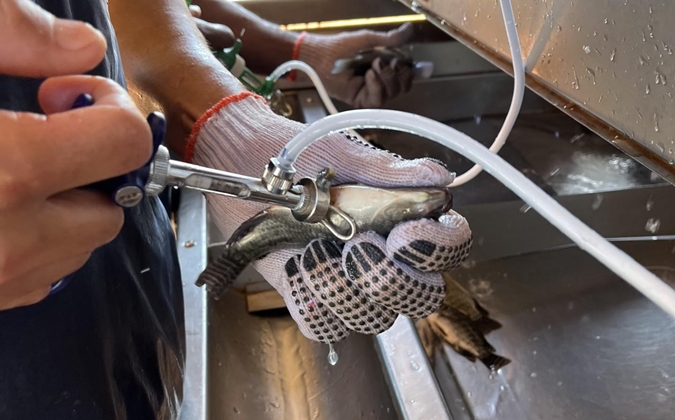
China making up for lost time in aquatic vaccine development
China’s progress in aquaculture has been great, with the country now responsible for over 70% of global farmed-fish production. Finding appropriate responses to fish disease has not been as rapid, researchers from Huazhong Agricultural University acknowledged — but new options in development suggest that the nation is fast catching up.
“The creation of a sustainable aquaculture industry depends on the development and implementation of vaccines and vaccination strategies that make the disease situation predictable and manageable under intensive production,” the scientists said in a review published in Fish & Shellfish Immunology.
China has a two-stage vaccine approval process, with new products first requiring the national veterinary drug certificate before they can receive a license to allow commercial production, the article noted. So far, seven aquatic vaccines — six domestic and one imported — have passed the first bureaucratic hurdle, and four have made it past the second stage. Following is an overview of aquatic vaccine progress in China to date.
Killed- and live-vaccine options for grass carp disease
Grass carp haemorrhagic disease, caused by the grass carp reovirus (GCRV), causes multi-million-dollar losses annually and was the first viral fish disease studied in China. Early vaccine research in the 1960s focused on inactivated vaccine using tissue from diseased fish, they said, but this approach was superseded by a cell-cultured vaccine in 1986 which brought much better results. It became the first certified aquatic vaccine in China in 1992.
A live vaccine against GCRV was also cleared for production in 2011, following over 2 decades of study. The authors highlighted regional trials which have been conducted in provinces across China with relative percent survival (RPS) rates observed of over 90%.
Progress in tackling bacterial pathogens
Bacterial sepsis caused by Aeromonas hydrophila causes serious losses in Chinese aquaculture. Antibiotic resistance in this pathogen makes vaccine production essential, the researchers explained. A killed whole-cell vaccine applicable to several fish and other aquatic species was developed throughout the ’90s and given commercial approval in 2011.
“This vaccine can effectively prevent the outbreak and prevalence of A. hydrophila sepsis in silver carp, crucian carp, bighead carp and bream, as well as in Chinese softshell turtles and bullfrogs, with an RPS of 70%,” they said.
Edwardsiella tarda is another bacterial pathogen of key interest due to its negative impact on the turbot market and concerns over antibiotic use. A live vaccine has proved effective in tackling a prevalent strain of the bacterium, they explained, and in 2016, it became the first government-certified vaccine against E. tarda in the world.
“The cumulative immunization coverage has exceeded 2 million individuals, which has resulted in the economic benefits of over 50 million RMB (over US $7 million) in total,” they added.
Vaccines against multiple threats developed
Japanese flounder is one of the main farmed marine fish in north China — but multiple bacteria, including E. tarda, Vibrio alginolyticus and Vibrio parahaemolyticus, threaten the continued success of production. The authors explained that this has led to the exploration of options targeting more than a single pathogen at once.
“At present, with the development of new breeding modes (high yield, high efficiency, high intensity), the bacterial diseases are presenting new features, such as cross-infection, mixed infections and multiple infections,” they said. “Therefore, some researchers have carried out studies on bivalent, trivalent and multivalent vaccines.”
This focus has led to the development and initial approval of a trivalent antibody vaccine for the three bacteria — the first such vaccine for marine fish in China.
The researchers also pointed out that steps have been made to combine inactivated vaccine for infectious spleen and kidney necrosis virus (ISKNV) with that for A. hydrophila in mandarin fish. The results so far show an RPS of 73.3% in fish affected by ISKNV and 60% for those with A. hydrophila infection.
Genetic engineering may help in the fight against various pathogens, they added. Vibrio anguillarum is a bacterium which affects a range of farmed-fish species, and the use of its genetic material in a recombinant vaccine for turbot has shown promising results. There is further potential in a DNA vaccine targeting V. anguillarum in Asian sea bass and another offering cross-protection against both V. anguillarum and Streptococcus iniae in Japanese flounder.
Improvements needed for commercial application
Despite the successes to date, the researchers highlighted three areas where work is needed to ensure continued progress toward the mass availability of Chinese aquatic vaccines.
“Firstly, the appropriate vaccine delivery route takes the lead in the application of vaccination for fish farmers. Secondly, the proper immune antigens are essential for the vaccination efficiency, which needs to be screened via new genomic methods. Thirdly, adjuvants are necessary to activate and direct the innate and adaptive immune responses for developing vaccines with more predictable efficacy,” they concluded.
To view the full study, click here.
Posted on: November 02, 2020






